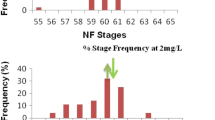Abstract
Perfluorooctane sulfonic acid (PFOS), as a potential endocrine disrupting chemical, is widely detected in the environment, wildlife and human. Currently few studies have documented the effects of chronic PFOS exposure on thyroid in aquatic organisms and the underlying mechanisms are largely unknown. The present study assessed the effect of chronic PFOS exposure on thyroid structure and function using zebrafish model. Zebrafish at 8 h post fertilization (hpf) were exposed to PFOS (250 µg/l) until 120 d post fertilization (dpf). Thyroid hormone (T3 and T4) level, thyroid morphology and thyroid function related gene expression were evaluated in zebrafish at 120 dpf. Our findings demonstrated that chronic PFOS exposure altered thyroid hormone level, thyroid follicular cell structure and thyroid hormone related gene expression, suggesting the validity of zebrafish as an alternative model for PFOS chronic toxicity screening.




Similar content being viewed by others
References
Austin ME, Kasturi BS, Barber M, Kannan K, MohanKumar PS, MohanKumar SM (2003) Neuroendocrine effects of perfluorooctane sulfonate in rats. Environ Health Perspect 111:1485
Builee TL, Hatherill JR (2004) The role of polyhalogenated aromatic hydrocarbons on thyroid hormone disruption and cognitive function. Rev Drug Chem Toxicol 27:405–424. https://doi.org/10.1081/dct-200039780
Butenhoff JL, Ehresman DJ, Chang S-C, Parker GA, Stump DG (2009) Gestational and lactational exposure to potassium perfluorooctanesulfonate (K + PFOS) in rats. Dev Neurotox Reprod Toxicol 27:319–330. https://doi.org/10.1016/j.reprotox.2008.12.010
Chang S-C, Ehresman DJ, Bjork JA, Wallace KB, Parker GA, Stump DG, Butenhoff JL (2009) Gestational and lactational exposure to potassium perfluorooctanesulfonate (K + PFOS) in rats: toxicokinetics, thyroid hormone status, and related gene expression. Reprod Toxicol 27:387–399
Chen J et al (2014) Early life perfluorooctanesulphonic acid (PFOS) exposure impairs zebrafish organogenesis. Aquat Toxicol 150:124–132
Cheng J et al (2016) Chronic perfluorooctane sulfonate (PFOS) exposure induces hepatic steatosis in zebrafish. Aquat Toxicol 176:45–52. https://doi.org/10.1016/j.aquatox.2016.04.013
Crane HM, Pickford DB, Hutchinson TH, Brown JA (2004) Developmental changes of thyroid hormones in the fathead minnow, Pimephales Promelas. Gen Comp Endocrinol 139:55–60
Cui Y et al (2017) Chronic perfluorooctanesulfonic acid exposure disrupts lipid metabolism in zebrafish. Human Exp Toxicol 36:207–217. https://doi.org/10.1177/0960327116646615
Hagenaars A, Knapen D, Meyer I, Van der Ven K, Hoff P, De Coen W (2008) Toxicity evaluation of perfluorooctane sulfonate (PFOS) in the liver of common carp (Cyprinus Carpio). Aquat Toxicol 88:155–163
Hoff PT, Van Dongen W, Esmans EL, Blust R, De Coen WM (2003) Evaluation of the toxicological effects of perfluorooctane sulfonic acid in the common carp (Cyprinus carpio) Aquat Toxicol 62:349–359. https://doi.org/10.1016/s0166-445X(02)00145-5
Hoff PT et al (2005) Perfluorooctane sulfonic acid and organohalogen pollutants in liver of three freshwater fish species in Flanders (Belgium): relationships with biochemical and organismal effects. Environ Pollut 137:324–333
Huang H et al (2010) Toxicity, uptake kinetics and behavior assessment in zebrafish embryos following exposure to perfluorooctanesulphonicacid (PFOS). Aquat Toxicol 98:139–147. https://doi.org/10.1016/j.aquatox.2010.02.003
Knox SS, Jackson T, Frisbee SJ, Javins B, Ducatman AM (2011) Perfluorocarbon exposure, gender and thyroid function in the C8 Health Project. J Toxicol Sci 36:403–410
Kotrschal K, Krautgartner WD, Hansen A (1997) Ontogeny of the solitary chemosensory cells in the zebrafish, Danio Rerio. Chem Sens 22:111–118
Lau C, Lindstrom AB, Seed J (2009) Perfluorinated chemicals 2008: PFAA Days II meeting report and highlights. Reprod Toxicol 27:429–434
Patiño R, Wainscott MR, Cruz-Li EI, Balakrishnan S, McMurry C, Blazer VS, Anderson TA (2003) Effects of ammonium perchlorate on the reproductive performance and thyroid follicle histology of zebrafish. Environ Toxicol Chem 22:1115–1121
Porazzi P, Calebiro D, Benato F, Tiso N, Persani L (2009) Thyroid gland development and function in the zebrafish model. Mol Cell Endocrinol 312:14–23
Schmittgen TD, Livak KJ (2008) Analyzing real-time PCR data by the comparative CT method. Nat Protoc 3:1101–1108
Shi X, Liu C, Wu G, Zhou B (2009) Waterborne exposure to PFOS causes disruption of the hypothalamus–pituitary–thyroid axis in zebrafish larvae. Chemosphere 77:1010–1018
Walpita CN, Crawford AD, Janssens EDR, Van der Geyten S, Darras VM (2009) Type 2 iodothyronine deiodinase is essential for thyroid hormone-dependent embryonic development. and pigmentation in zebrafish. Endocrinology 150:530
Wang M et al (2011a) Chronic zebrafish PFOS exposure alters sex ratio and maternal related effects in F1 offspring. Environ Toxicol Chem 30:2073–2080
Wang T, Chen C, Naile JE, Khim JS, Giesy JP, Lu Y (2011b) Perfluorinated compounds in water, sediment and soil from Guanting Reservoir. China Bull Environ Contam Toxicol 87:74–79
Yu W-G, Liu W, Jin Y-H, Liu X-H, Wang F-Q, Liu L, Nakayama SF (2009) Prenatal and postnatal impact of perfluorooctane sulfonate (PFOS) on rat development: a cross-foster study on chemical burden and thyroid hormone system. Environ Sci Tech 43:8416–8422
Zhang W et al (2011) Perfluorinated chemicals in blood of residents in Wenzhou. China Ecotoxicol Environ Saf 74:1787–1793. https://doi.org/10.1016/j.ecoenv.2011.04.027
Acknowledgements
We thank Zhouxi Fang for technical help with TEM. This work was supported by the Key Project of Natural Science Foundation of Zhejiang Province (LZ13B070001) and the Natural Science Foundation of China (21277104 and 21307096) and the Science and Technology Project of Wenzhou (H20100062 and Y20170147).
Author information
Authors and Affiliations
Corresponding authors
Rights and permissions
About this article
Cite this article
Chen, J., Zheng, L., Tian, L. et al. Chronic PFOS Exposure Disrupts Thyroid Structure and Function in Zebrafish. Bull Environ Contam Toxicol 101, 75–79 (2018). https://doi.org/10.1007/s00128-018-2359-8
Received:
Accepted:
Published:
Issue Date:
DOI: https://doi.org/10.1007/s00128-018-2359-8




